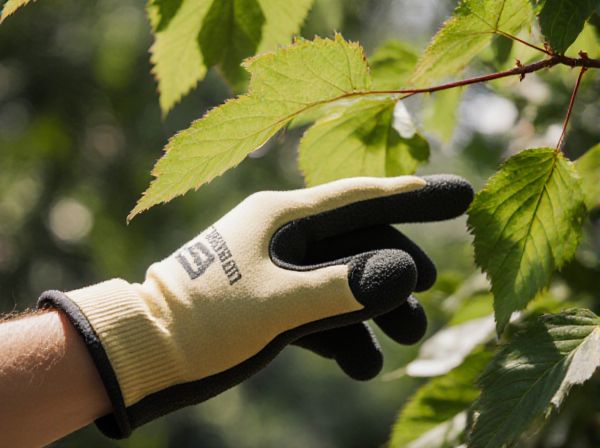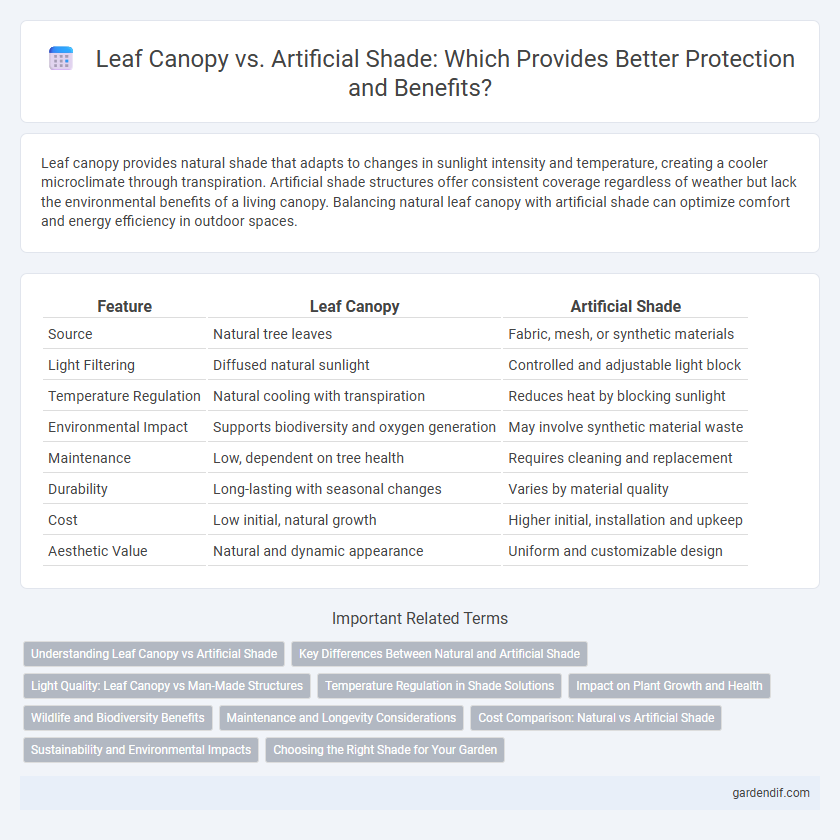
Leaf canopy vs artificial shade Illustration
Leaf canopy provides natural shade that adapts to changes in sunlight intensity and temperature, creating a cooler microclimate through transpiration. Artificial shade structures offer consistent coverage regardless of weather but lack the environmental benefits of a living canopy. Balancing natural leaf canopy with artificial shade can optimize comfort and energy efficiency in outdoor spaces.
Table of Comparison
| Feature | Leaf Canopy | Artificial Shade |
|---|---|---|
| Source | Natural tree leaves | Fabric, mesh, or synthetic materials |
| Light Filtering | Diffused natural sunlight | Controlled and adjustable light block |
| Temperature Regulation | Natural cooling with transpiration | Reduces heat by blocking sunlight |
| Environmental Impact | Supports biodiversity and oxygen generation | May involve synthetic material waste |
| Maintenance | Low, dependent on tree health | Requires cleaning and replacement |
| Durability | Long-lasting with seasonal changes | Varies by material quality |
| Cost | Low initial, natural growth | Higher initial, installation and upkeep |
| Aesthetic Value | Natural and dynamic appearance | Uniform and customizable design |
Understanding Leaf Canopy vs Artificial Shade
Leaf canopy provides natural shade through the overlapping foliage of trees, which filters sunlight and creates a cooler microclimate by promoting evapotranspiration. Artificial shade, such as fabric canopies or shade sails, blocks sunlight physically but lacks the ecological benefits of leaf canopies, including air purification and habitat support. Understanding the differences highlights leaf canopy's role in sustainable shading solutions compared to the more controlled but less environmentally interactive artificial shade.
Key Differences Between Natural and Artificial Shade
Leaf canopy provides natural shade through the dense arrangement of leaves, offering eco-friendly cooling and air purification by filtering sunlight and releasing oxygen. Artificial shade, created by structures such as umbrellas or canopies, delivers consistent and customizable coverage but lacks the environmental benefits of natural foliage. The key differences lie in sustainability, microclimate effects, and impact on local ecosystems.
Light Quality: Leaf Canopy vs Man-Made Structures
Leaf canopies naturally filter sunlight by diffusing and scattering light, creating a spectrum rich in red and far-red wavelengths essential for plant photosynthesis and growth regulation. Artificial shade structures often block light uniformly, reducing overall intensity but lacking the spectral complexity found in natural leaf canopies. The difference in light quality between leaf canopy and man-made shades influences plant development, with natural canopies promoting more balanced photomorphogenic responses.
Temperature Regulation in Shade Solutions
Leaf canopies provide natural temperature regulation by facilitating evapotranspiration, which cools the surrounding air and maintains a stable microclimate beneath. In contrast, artificial shade structures reduce direct solar radiation but often lack the cooling effects of moisture release, resulting in higher ambient temperatures. Optimal shade solutions integrate natural elements with engineered designs to enhance thermal comfort and energy efficiency.
Impact on Plant Growth and Health
Leaf canopy provides natural shade that regulates temperature and light intensity, promoting optimal photosynthesis and reducing plant stress. Artificial shade often creates uniform light diffusion but may lack the microclimate benefits of leaf canopies, potentially affecting humidity levels and air circulation. Research shows plants under natural leaf canopies generally exhibit improved growth, enhanced disease resistance, and better overall health compared to those grown solely under artificial shade structures.
Wildlife and Biodiversity Benefits
Leaf canopies provide crucial habitats and food sources for a wide range of wildlife, supporting greater biodiversity compared to artificial shade structures. Natural foliage facilitates pollination, nesting, and shelter, enhancing ecosystem services and promoting species diversity. Artificial shade lacks the complex ecological functions of leaf canopies, offering limited benefits for wildlife and biodiversity conservation.
Maintenance and Longevity Considerations
Leaf canopy requires regular pruning and seasonal care to maintain optimal shade density and health, with natural wear influencing its longevity typically spanning several years depending on tree species. Artificial shade structures, made from materials like UV-resistant fabrics or metal, generally demand less frequent maintenance, primarily involving cleaning and inspecting for damage, with lifespans ranging from 5 to 15 years based on material quality and environmental exposure. The choice between leaf canopy and artificial shade hinges on balancing ongoing upkeep efforts with durability needs in specific outdoor settings.
Cost Comparison: Natural vs Artificial Shade
Leaf canopy offers a cost-effective natural shade solution with zero installation expenses and minimal maintenance, primarily relying on the growth of trees to provide cooling benefits. Artificial shade structures, such as metal or fabric canopies, require significant upfront costs for materials and professional installation, along with ongoing maintenance and potential replacement costs. Over time, natural leaf canopies deliver lower overall expenses compared to artificial shades due to their sustainability and negligible upkeep requirements.
Sustainability and Environmental Impacts
Leaf canopy provides a natural and renewable source of shade that supports biodiversity, improves air quality, and contributes to carbon sequestration, enhancing overall environmental sustainability. Artificial shade structures often rely on materials with higher carbon footprints and limited recyclability, leading to increased waste and energy consumption during production and disposal. Integrating leaf canopies into urban planning reduces heat island effects and promotes ecological balance more effectively than synthetic alternatives.
Choosing the Right Shade for Your Garden
Leaf canopy provides natural shade that enhances biodiversity and improves soil health by allowing filtered sunlight to reach understory plants, promoting a balanced microenvironment. Artificial shade structures offer customizable light filtration and protection from harsh sunlight, making them ideal for specific plant needs or limited garden spaces. Selecting the right shade depends on factors such as plant species, garden layout, and desired sunlight exposure to optimize growth and sustainability.
Leaf canopy vs artificial shade Infographic

 gardendif.com
gardendif.com